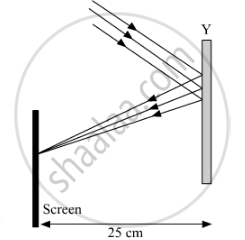Advertisements
Advertisements
Question
An object 3 cm high is placed 24 cm away from a convex lens of focal length 8 cm. Find by calculations, the position, height and nature of the image.
Solution
Given:
Object distance (u) =-24
Focal length (f) = +8
Object height (h) = 3 Lens formula is given by:1f=1v-1u⇒18=1v-1-24⇒18=1v+124⇒18-124=1v⇒3-124=1v⇒224=1v ⇒ v=12 cm Image will be form at a distance of 12 cm on the right side of the convex lens.Magnification m=vu ⇒ m=12-24
⇒m=-12So, the image is diminished. Negative value of magnification shows that the image will be real and inverted.">
Lens formula is given by :
`1/f=1/v-1/u`
`1/8=1/v-1/-24`
`1/8=1/v+1/24`
`1/8-1/24=1/v`
`(3-1)/24=1/v`
`2/24=1/v`
`v=12 cm`
Image will be form at a distance of 12 cm on the right side of the convex lens.
Magnification m `v/u`
`m=12/-24`
`m =-1/2`
so, the image is diminished
Negative value of magnification shows that the image will be real and inverted.
`m=h_i/h_o`
`-1/2=h_i/3`
`h_i =-3/2`
`h_i=-1.5` cm
Hight of the image will be 1.5 cm Here, negative sign shows that the image will be in the downard direction
APPEARS IN
RELATED QUESTIONS
An object of height 2.5 cm is placed at a distance of 15 cm from the optical centre 'O' of a convex lens of focal length 10 cm. Draw a ray diagram to find the position and size of the image formed. Mark optical 'O', principal focus F and height of the image on the diagram.
Study the given ray diagrams and select the correct statement from the following:


(A) Device X is a concave mirror and device Y is a convex lens, whose focal lengths are 20 cm and 25 cm respectively.
(B) Device X is a convex lens and device Y is a concave mirror, whose focal lengths are 10 cm and 25 cm respectively.
(C) Device X is a concave lens and device Y is a convex mirror, whose focal lengths are 20 cm and 25 cm respectively.
(D) Device X is a convex lens and device Y is a concave mirror, whose focal lengths are 20 cm and 25 cm respectively.
The diagram given alongside shows a ray of light entering a rectangular block of glass.
(a) Copy the diagram and draw the normal at the point of entry.
(b) Draw the approximate path of the ray of light through the glass block and out of the other side.
Three convex lenses are available having focal lengths of 4 cm, 40 cm and 4 m respectively. Which one would you choose as a magnifying glass and why?
A student did an experiment with a convex lens. He put an object at different distances 25 cm, 30 cm, 40 cm, 60 cm and 120 cm from the lens. In each case he measured the distance of the image from the lens. His results were 100 cm, 24 cm, 60 cm, 30 cm and 40 cm, respectively. Unfortunately his results are written in wrong order.
Rewrite the image distances in the correct order.
What would be the diameter of the image of the flower on the film?
What type of lens is used to correct
hypermetropia
A lens forms an upright and magnified image of an object. Name the lens.
Where must a point source of light be placed in front of a convex lens so as to obtain a parallel beam of light?
State the nature and position of the object on the principal axis to obtain a real image of the same size
